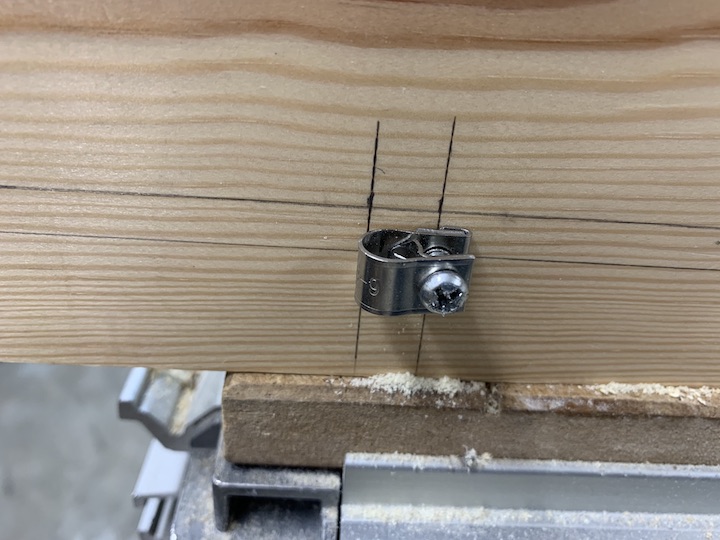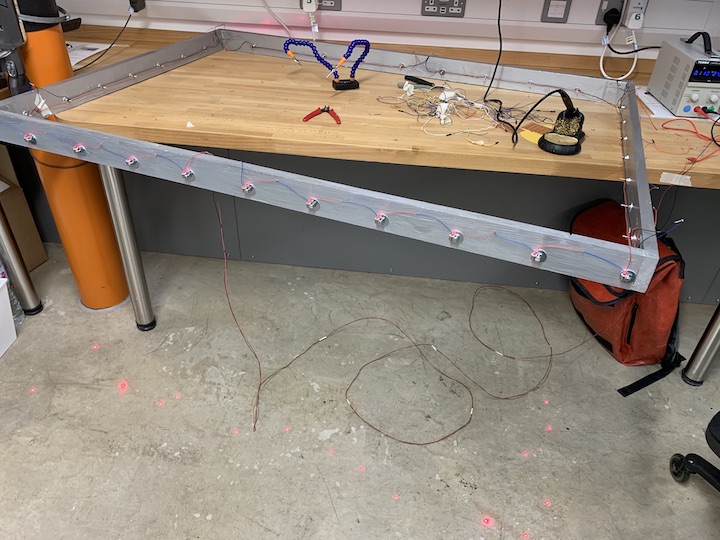In the Name of Love
This is a performatively audio-visual installation with non-linear and multi-layer interactions based on real time. By creating the installation, the artist aims to explore the ILLUSIONS generated by physical body movement between the technical system and the social system.
Key words: Live art, narratives, cybernetic cinema, real-time computer film, non-linear and multi-layer interactions, system
produced by: Baqi Ba
Introduction
In the Name of Love explores live cinematic performance as a system in order to discuss narratives based on cybernetic cinema. During a live performance, the entire performance system is composed of all elements of the performance, leading to a ‘circular-causal’ loop relationship which attends every material that occurs in performances. Due to the incidentally interactive relationship among them, narratives are randomly generated in this relationship.
Materials: Moving images, lasers, LED strips, Arduino Uno board, microphone, piezo sensors, speakers, webcam, computational program, audience, wood
Concept and background research
‘What is the most real illusion at the moment?’ is the question that I proposed in this work. For example, in the context of all things connected through digital signal, seems we have been to every corner of the world, seems we are in various "party", seems we understand happiness and pain, seems we have witnessed the war that took place, seems to have met tens of thousands of people, seems we have recognized the code of the world running, seems we owned the future, seems we have mastered the truth... We got all of these illusions from body movement at the most beginning, like we have a smart phone connected wifi, but still need moving fingers, swiping screens, typing keyboard to get information from website. This is the reason why I use an audio related to body training as the main audio.
There are two reasons why I choose a broadcast gymnastics as main audio as lots of musics for body trainning able to be found. Firstly, the broadcast gymnastic in my memory is the first time made me experienced that I am under a system. Because thousands of students do the same body movement together at 10am everyday on the playground. Like this,
Secondly, the earliest broadcast was created by a young Germany for military around 200 years ago, then developed to all over the world. During the Second World War, especially when some country was colonised, one of the main ways to do a brainwashing is broadcast gymnastics. This situation is quite like nowadays human was controlled by digital signal and number of data. For example, when phone message is ringed, we’ll take out phone, swiping the screen, typing on keyboard ... It seems that there is a trigger in our brains. In broadcast gymnastics, people are trained by linstenning 1234 5678... then react with body position in their mind. This is quite similiar as people nowdays who are controlled by digital signal and data.
The first time Chinese people came into contact with "broadcast gymnastics" was from a humiliating history. After 1935, the Japanese and puppet government promoted the "Jianguo Gymnastics" and "Xinmin Gymnastics" which are very similar to broadcast gymnastics in "Three Eastern Provinces" in China. This is to strengthen the so-called "slavish education" and allow the Chinese people to accept the brainwashing of militarism. While, after the reform and opening in the 1970s, due to Chinese government's vigorous publicity and encouragement, radio gymnastics began to become a positively physical activity.
Technical
For software, I mainly used Max Msp and Arduino, including the ready generated video made by Max Msp, generated spectrogram audio, and the lasers are controlled through serial communication between Max Msp and Arduino.
The use of computational media in this work, in addition to the purely technical level, the internal production system and technical logic that support the entire performance structure is hidden under the appearance that the audience can see. There are multiple inputs and outputs, multi-layer interactions as well. The interactions are not only in computational way, but also in physical way. For example the piezo sensors under the stage, not connected any program, but when someone moving on the stage, the sound from piezo will be mixed with other audio together and then sense the laser. At the same time, when someone on the stage, the webcam will track it, generate the spectre audio and mix with other audios as well. That is to say, the input is not the only input, but one of the inputs. For outputs as well. Additionally, they are both of input and output in this system at some point.
So the entire structure includes and integrates the dissemination of sound, video and spatial information, as well as the visual, auditory and physical movements of the audience. The purpose of hiding behind is also to make it easy for viewers to experience “feeling" itself, including seeing, listening, surrounding, imaging and experiencing their own body movements. In my mind, computational media as system is just a part of whole society. So it has to be within relations with others to achieve it.
Construction process and challenges
Fortunately, I picked up the wooden frame and platform on the street that were exactly the size I needed. This saved a large part of my setup time. Next, I designed and built a laser stabilization, laser circuits (each six lasers are connected in series, and six series circuits are connected in parallel) and a platform for pedaling. There are a few piezo sonic sensors hidden under this platform to amplify the friction sound between the wooden board and the steel wire balls. This is in order to create a sense of hearing that sounds like stepping on artificial grass.
Since this is a space-based work, most of the challenges occurred in the process of building at the exhibition space. For example, the entire laser structure was originally intended to be hung up to the ceiling, which aimed to hide the source of the lasers. In this way, when the lasers hit the ground from top would be like a cage with a sense of invisible control. While, after discussing with the technicians and considering various safety issues, I decided to put it on the floor. As a result, I got this unexpired but surprising experience. It seems to see twinkling stars when looking up at the ceiling.
There is one more major challenge that has to be mentioned. The exhibition space I was initially assigned to was G04, not this G03. But the other student sharing G04 with me has been changing her exhibition plan during setup time. Her final decision was completely different from the plan we had discussed at the beginning. This resulted in no way for me to show my work at all. Until that moment, I already almost finished everything, including adjusting details based on the space and filming documentation. So two days before the opening, I dismantled the installation, moved it to G03 and reinstalled it. Anyway, due to the higher ceiling in G03, the final presenting is spatially better than in G04, I think.
Future development
My intension is always to explore the feature of computational media, especially the relation between society system and it. As I explained above what the computational media is like in my mind, practically, I will try to explore the mothod on presenting 'relations' in order to make audiences feel everything happens naturally. People don’t have to look for where the sensor is, which type of the sensor is and how to interact with it when facing my work. They may not know it is interactive, but still performantive for them.
However, in a live work for an audience, the most important and necessary aspect is not necessarily sensing each element separately, but the experience itself. That is to say, within the space of live cinematic performance, space, audience, moving images, light, even the artist’s concepts are being used as materials to build an entire system. Within a computational system, in addition to controllable constants and variables, there will be infinitely random variables and even unexpected bugs such as trends on the internet which have been spread by the public and are out of ‘official’ control. Thus, beyond the clear and visible relations among each material, it is worth considering the dynamic possibilities of generated narratives with more ambiguousand invisible connections in the future.
Self evaluation
For this work, what I mainly want to achieve is breaking the one-to-one human-machine interaction, to build a system with non-linear and multi-layer interactions. The wooden platform here is the most directly participative sensor, but I hope that whether audiences know the platform able to be interacted or not, the whole system can work very well. If viewers realise that, I hope they would feel they are in a cage built by signal when they are standing on the platform.
References
https://www.uio.no/ritmo/english/research/labs/fourms/downloads/software/AudioVideoAnalysis/
http://adsr.jp
YOUNGBLOOD, G. (2019). EXPANDED CINEMA. [S.l.]: FORDHAM UNIVERSITY PRESS.
Grice, M. (1977). Le Grice, Malcolm Abstract film and beyond. Cambridge, Mass: MIT Press.
Frieling, R. and Daniels, D. (2003). Media art net 1. Wien: Springer.
Laurel, B. (2014). Computers as theatre. Upper Saddle River, NJ: Addison-Wesley.
E-flux.com. (2019). Curating in the Post-Internet Age - Journal #94 October 2018 - e-flux. [online] Available at: https://www.e-flux.com/journal/94/219462/curating-in-the-post-internet-age/ [Accessed 11 May 2019].
Yuk, H. (2018). Preface: The Time of Execution. In: H. Prichard, Snodgrass, Tyżlik-Carver, ed., Exciting Practices, 1st ed. Open Humanities Press, pp.25-34.
Graham, B. and Cook, S. (2010). Rethinking curating. MIT Press.
Gillette, F. (1973). Notes fir a Proposal on Conceptual Gaming. In: E. Shanken, ed., system, 1st ed. London: Whitechapel Gallery, The MIT Press, pp.75-78.
Meadows, D. and Wright, D. (n.d.). Thinking in systems.
Chun, W. H. K. (2016). Updating to remain the same : Habitual new media. ProQuest Ebook Central https://ebookcentral.proquest.com
Taylor & Francis. (2019). Digital Narratives and Witnessing: The Ethics of Engaging with Places at a Distance. [online] Available at: https://www.tandfonline.com/doi/full/10.1080/2373566X.2016.1234940 [Accessed 29 Nov. 2019].
En.wikipedia.org. (2019). Cybernetics. [online] Available at: https://en.wikipedia.org/wiki/Cybernetics [Accessed 11 May 2019].




































































